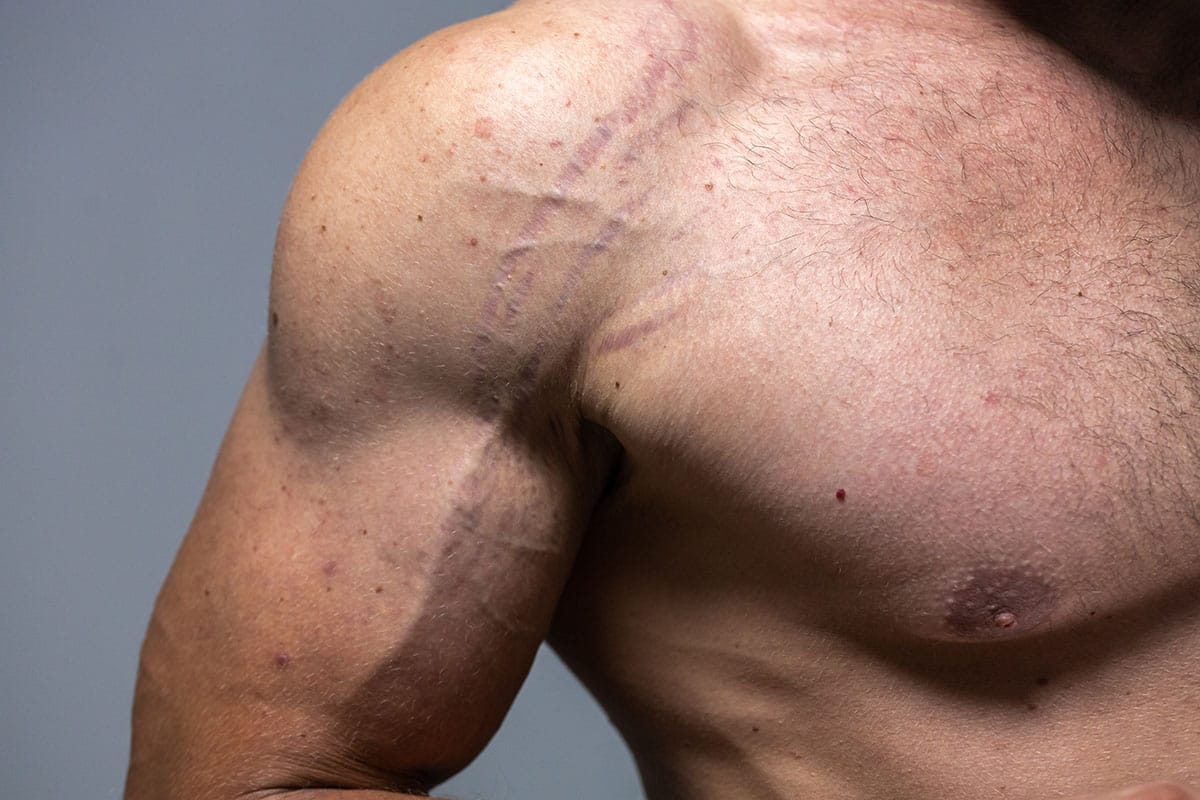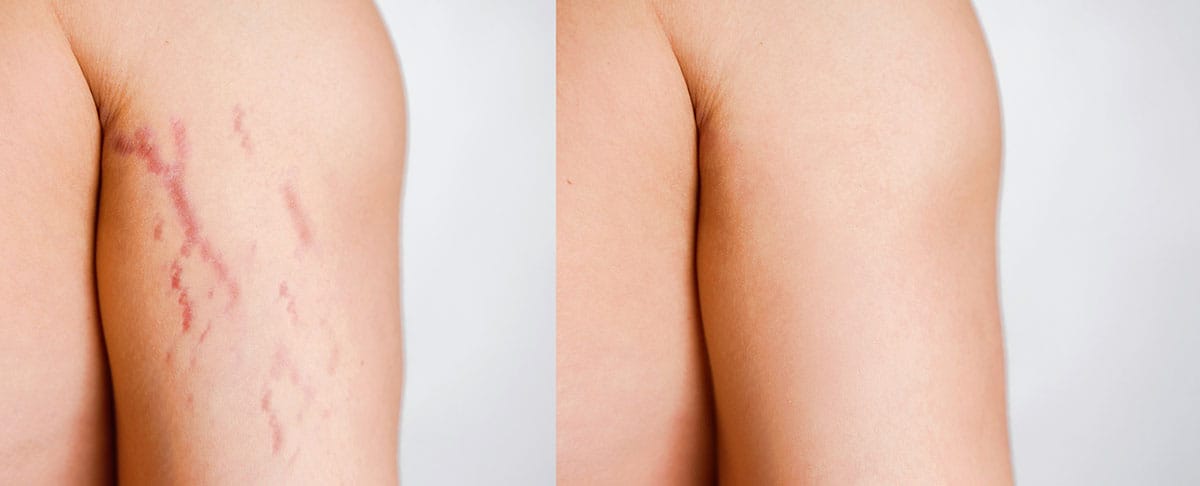Why Do I Have Bicep Stretch Marks?
Stretch marks, also called “striae,” are a normal part of body changes, especially with muscle growth or weight fluctuations.
Bicep stretch marks, in particular, can be a concern for fitness enthusiasts and bodybuilders who push their limits to achieve their desired physique.
If you’re a practitioner of aesthetic workouts and care about your body’s appearance, it feels defeating to do all that work on your biceps in the gym only to have them covered in red marks and not looking their best.
In this blog, we will explore the causes of bicep stretch marks, effective ways to prevent them, and treatments available to minimize their appearance.
How Do Stretch Marks Form?
Stretch marks can refer to any kind of abnormal lines on the skin where the skin has stretched or shrunken too quickly.
Usually, these marks will be red, reddish-brown or purple in color when they are fresh. Often, over time, they can fade to white or a shade more similar to your natural skin tone.
These marks are considered a form of dermal scarring where the “dermis” layer of your skin stretches beyond its natural capacity.

What Causes Bicep Stretch Marks?
Stretch marks on the biceps or other parts of your body can form for several reasons, including:
1. Muscle Growth
When you experience quick gains in muscle size, like during weight training, your skin may not have enough time to stretch gradually. This can cause small tears to what’s called your “dermis,” the middle layer of your skin.
If your skin doesn't adapt quickly enough to your muscle gains, it can result in stretch marks. Quicker bicep growth usually comes from weight training.
Although the aim of weight training is typically to increase the size of your biceps through muscle gain, this can lead to stretch marks if you gain muscle faster than your skin can stretch to accommodate it.

2. Puberty
During puberty, most of us tend to gain significant height, weight or both.
This is a good thing since it prepares teenagers’ bodies to enter into adulthood. That being said, puberty results in dramatic changes over a short time period.
For most people, you’ll see puberty-related changes in the body for a period of about 2-5 years. Cramming all of these changes— overall size growth among the main ones— into such a short period is challenging for your body.
3. Pregnancy
During pregnancy, many mothers will experience stretch marks around their stomachs since rapid stretching of the skin is required to carry a baby.
4. Growth Spurts
If you grow taller, even outside of puberty, your skin can stretch, leading to marks.
5. Hormonal Changes
Fluctuating hormones out, particularly during puberty or due to certain conditions, can affect skin elasticity and make it more prone to stretch marks, even without significant weight or muscle changes.
6. Weight Gain
Gaining body weight too quickly can also cause your skin to stretch beyond its normal capacity. This can cause stretch marks, especially in areas like the biceps.

7. Genetics
Some people are genetically predisposed to stretch marks due to differences in skin elasticity.
If family members have stretch marks, you might be more likely to get them, too.
8. Dry Skin
Skin that is dry or lacks hydration may be less flexible, making it more prone to developing stretch marks when stretched.
How Do I Get Rid of Bicep Stretch Marks?
If you happen to have bicep stretch marks, don’t worry because there are treatments for that.
1. Laser Treatment
Aesthetic or medical laser treatments can help you get rid of stretch marks. Light therapy or lasers like Fraxel are commonly used to repair skin damage as a non-invasive procedure.
2. Microneedling
Microneedling involves pricking your skin with tiny needles to send a signal to your body to produce more collagen and elastin.
These are two naturally occurring proteins that contribute to your skin’s elasticity. Your body produces less of these substances as you age, but if you’re experiencing stretch marks, it’s possible that you’re low in one or both of these.
To heal the micro-wounds, your body sends more collagen and elastin to the treatment areas, which can be beneficial if you’re struggling with bicep stretch marks.
3. Microdermabrasion
This type of treatment breaks up the outer layer of your skin in order to remove damaged skin, like you’d see in stretch marks.
Make sure to speak to your doctor or dermatologist if you’re interested in any of these treatments for bicep stretch marks. They can help decide if you’re a good candidate and what treatment type would be most suitable for your particular skin condition.
How Do I Prevent Bicep Stretch Marks?

The bottom line is that there are some stretch marks you’ll be able to stop in their tracks before they happen and some that you won’t.
Nothing you do is a guarantee that you’ll never get bicep stretch marks. That being said, there are many strategies you can try preventively for the management of stretch marks.
Here are a few of the best ways to prevent stretch marks on your biceps.
Gain Muscle Slowly
From a weight training perspective, the best approach you can take to training your biceps if you start to notice stretch marks forming is to take things slow and steady.
For new weightlifters, especially, it can be tempting to gain as much as you can as quickly as possible.
If you’re super skinny, for example, the temptation to dirty bulk solely to put on as much size as you can quickly might be ringing in your mind.
Moisturize!
Keeping your skin hydrated and elastic, especially as you age is one of the best stretch mark solutions you can use.
Opt for creams or oils rich in vitamin E or shea butter. These can help minimize the look of any stretch marks you already have. They will also help keep your skin moisturized to prevent more marks from forming.
Diet
No, your diet won’t completely prevent or reverse stretch marks.
However, looking for certain nutrients or dietary staples can help contribute to the overall health of your skin.
Look for foods that are high in:
- Zinc: Opt for foods like red meat, seafood, poultry and nuts to introduce more zinc to your diet.
- Lean protein: You can find this in foods like chicken breast, beans, lentils, eggs, etc.
- Vitamin A: Try squash, carrot, spinach, sweet potato, bell pepper, beef liver, and broccoli.
- Vitamin C: You’ll find this in citrus fruits, potatoes, strawberries, and bell peppers.
- Vitamin D: Include egg yolks, fatty fish, mushrooms, and cod liver oil.
- Vitamin E: Try almonds, peanuts, sunflower seeds and pumpkin for more vitamin E.
All of these vitamins and nutrients can help you maintain the health of your skin so that you’re less prone to stretch marks.
Keep in mind too that dry skin is another thing you can partially remedy with diet. Namely, your hydration levels will need to be in check.
Although generally, your body’s thirst cues are a good indicator of whether or not you need to drink water, many of us are chronically dehydrated.
Big Picture
Stretch marks are a natural occurrence for most people and can sometimes happen whether you like them or not.
Bicep stretch marks are often associated with weight gain from weightlifting that causes the biceps to grow or excess fat on the arms.
Other causes of bicep stretch marks and stretch marks in general are:
- Puberty
- Pregnancy
- Hormonal Changes
- Poor Skin Elasticity
From a fitness perspective, to reduce your likelihood of bicep stretch marks, there are two main solutions: avoid excess body fat. This extra fat can cause your arms to become larger rapidly and thus to get stretch marks.
Point number two is to make sure your muscle growth goals are reasonable and that you don’t go too fast. If you have bad bicep genetics and are looking to grow more muscular arms, take things slowly.
Small increases in your strength training per week that follow a gradual progressive overload will help you A) avoid burning yourself out in the gym and B) start to grow your biceps slowly enough so your skin can adapt, reducing stretch marks.
References
Oakley AM, Patel BC. Stretch Marks. [Updated 2023 Aug 7]. In: StatPearls [Internet]. Treasure Island (FL): StatPearls Publishing; 2024 Jan-. Available from: https://www.ncbi.nlm.nih.gov/books/NBK436005/
Wollina, U., & Goldman, A. (2017). Management of stretch marks (with a focus on striae rubrae). Journal of cutaneous and aesthetic surgery, 10(3), 124–129. https://doi.org/10.4103/JCAS.JCAS_118_17
Related articles


Get fit with Flex
Build muscle & lose weight fast for free.
Available on iPhone + Apple Watch





